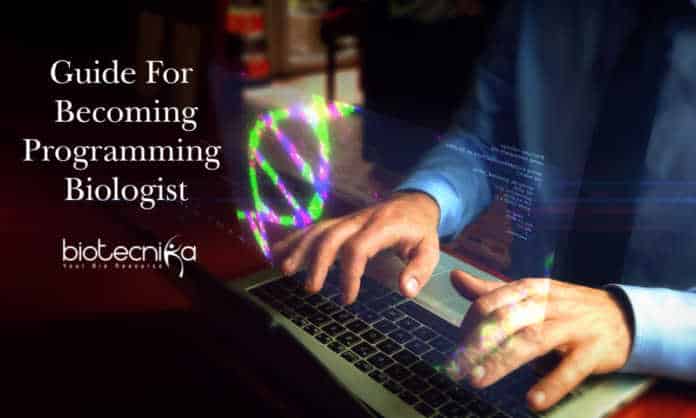Programming Biologist – Guide For Becoming One!
Have the idea of becoming a biology programmer ever stricken your mind? Is it so that you tried but later found yourself standing nowhere near to start? If the answer to both of these questions is yes, you are encouraged to give a try to the following resources. Computer science is one of the subjects which needs least certification and guidance and more of self-learning and practice, along with motivation and a computer connected to the internet!
As artificial intelligence and computers are becoming an important part of our lives, having knowledge only about biology theory is not going to help out. Skills should be combined with experimental design and interpretation that also requires an understanding of the analytical approach. While academic knowledge can aid in the implementation, computational literacy seems non-replaceable. In fact, the dry lab is getting more popularity compared to wet labs these days. So, hereby 10 simple steps are being mentioned to get acquire a computational skill set to become a perfect Programming Biologist.
Get Introduced To The Basics
It is always better to take a step back to learn the fundamentals of computer science first. Before you learn
the syntax of the language of your choice, you need to understand basic concepts such as data types, variables, conditionals, loops, arrays, functions, etc as well as the languages including C, PHP, JavaScript, SQL, CSS, and HTML. Also, it may be needed to increase your typing speed if you are not a regular user of the keyboard. Some of the learners also take a step further and ensure to write/run programs in a simple web-based IDE.Choose The Language Related To Your Work Of Interest
While selecting your primary language, consider the type of work being implemented. What exactly you want to achieve through this course: programming, designing, implementation, analysis? Advisable languages for biology researchers to become a Programming Biologist include: Python, followed by Julia, Pearl, R, Ruby. Python is especially easy to learn, contains multiple capabilities, and also includes a well-developed library of tools. To name a few Biopython, Galaxy, and Pygr. Python is also smoother to implement in a relatively shorter amount of time, as compared to C++ or Java.
If you’re unsure which program is right for you, do some research online, Spend some time reading up on the different pros/cons of the languages you have filtered as well as how steep the learning curve is. One can always learn multiple languages. However, it is advisable to master the first language before setting out to learn a second.
Don’t Hurry It, Take Baby Steps!
Once you’ve begun, specialize in one task at a time and apply your thinking and problem-solving expertise. This needs tackling a problem stepwise. Analysis of the overall information could sound challenging, however taking the baby steps will help a lot. e.g., First scan your information, decide on a way to interpret missing values, do the scaling, establish comparison conditions, calculate fold change, etc. Tackle these tasks one at a time. Iteratively edit for potency, flow, and conciseness. Don’t be afraid of committing mistakes, the more important thing is to notice, correct, and learn from them.
Immersion Is The Best Learning Tool
Do not sew along an analysis by shifting between or among languages, this is going to make the task more difficult. If possible, complete the job in one language or environment. Like, importing a spreadsheet of data (like you would view in Excel) is not necessarily straightforward; Excel automatically determines how to read a text, but the method may differ from conventions in other programming languages. If your date is not being read properly (misread), it is suggested to take the help of Excel.
However, these issues are fastened by correctly reading the information and by understanding the language’s data structures. Additionally, transferring across programs induces error. See References for additional Excel or word processing–induced errors. Eventually, you’ll establish tasks that don’t seem to be well matched to the language under consideration. At that time, it should be helpful to choose can build will make it easier to find out a second.
Practice Makes Perfect
Once you’ve started onto something, what comes next is relentless practice. Like any other field – a Programming Biologist career will also take lots of practice of constantly writing programs is going to make you perfect in this particular field. I hope you have learned of the famous fact “if you are going to spend 10,000 hours onto the subject of your choice, it will make you a Master of the same”. While doing the same, you’ll be handling certain small techniques, learning to think programmatically, and will eventually feel confident enough to apply your knowledge to real-world issues.
Take Help
There may be a whole lot of online resources in the form of documentation, sites, and tutorials as well as the communities to discuss the problems viz. Biostars, StackExchange, StackOverflow, etc., but nothing can substitute for a friend or colleague’s help. You may find one in your own university. If your lab or university does not have a community of programmers, take the help of certification courses online. Thereby, it will also be possible to get mailing lists for connecting with members. One can also get in contact with the help of events organized by language-specific user groups or interest groups focused on big data, machine learning, or data visualization in one’s city.
But before asking for help as well, you need to be clear about the problem yourself. First, interpret the error message. The process of understanding the problem is called “debugging”. Before starting the work go through previous papers, check experiments, get code from your friends, implement and interpret that code, discuss your queries with them, take their help in editing.
Do not start from the beginning if you are a complete newbie to this field.
Copy and paste is something which does not earn due respect in the scientific field. However, it becomes your fast friend with regard to programming. Try all the resources available, which include cool snippets of code your labmate shared, examples in the language’s documentation, online tutorials, published code, and your own past work. Read widely to identify these resources. It is also advised to give due credits and references.
Maintain Good Data Maintaining Habits
As a Programming Biologist, you will be dealing with loads & loads of data in terms of codes, theories & data collected. It is also advisable to maintain a computational lab notebook which will include protocols, codes, inputs, outputs, figures, interpretations and details of the programming. Develop a habit of organizing a drawer with relevant files for all the experiments handled by you in the past for quick access in the future. This saves a lot of time and boosts efficiency. Also, note down the modifications or changes in experimental or computational protocols.
Get Better Exposure
Try to collaborate with scientists in your research specific field. Together you can carry out a project, discover something new, that suits the taste of other people as well. It may help you get a publication in the form of research papers and review articles, that will, in turn, boost your credibility. You may also apply the new approach in already existing data from your past experiments that will improve the chances of the manuscript getting accepted in the best journals.
Specialization in Bioinformatics – A Must
After learning the basics and language selection, one must attain a specialization in Bioinformatics. Bioinformatics and computational biology are the fields every programming biologist must be acquainted with. Either you can pursue a full-time degree in it or go for certification courses. There exist tonnes of bioinformatics algorithms including Sequence Alignment, Motif Searching, Genome Assembly, Evolutionary Tree Reconstruction, Hidden Markov Models, Peptide Sequencing, and many more which comes in very very handy as a programming biologist. Additionally, next-generation sequencing tools and other methods in computational biology must also be known.
To get more details on the list of Bioinformatics Skills Required and Educational Qualifications for becoming a Programming Biologist visit the below link :
Is Programming Knowledge Necessary For Career In Bioinformatics?
Give It A shot!
These pieces of advice might help you judge the path ahead, though these may not be applicable to all of you. You will learn new facts and develop new skills well-suited to yourself.
Science is all about learning. The respect you earn in the scientific community is always proportional to the quality of research which is credible to you. Computers are not only for word and excel now. Softwares are an impeccable part of regularly upgrading researchers or learners. The resources and opportunities are endless. Computational expertise also makes a biologist much more marketable & presentable in terms of better job & career opportunities.
 Dr. Preeti Saini is Ph.D. in Soil Microbiology from Punjab Agricultural University, Dr. Saini wears many hats at BioTecNika. She is involved in designing Courses, coordinating conferences and loves to educate her students about the latest from the world of Life Sciences.
Dr. Preeti Saini is Ph.D. in Soil Microbiology from Punjab Agricultural University, Dr. Saini wears many hats at BioTecNika. She is involved in designing Courses, coordinating conferences and loves to educate her students about the latest from the world of Life Sciences.





































